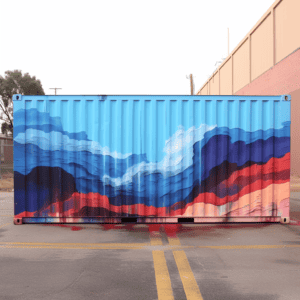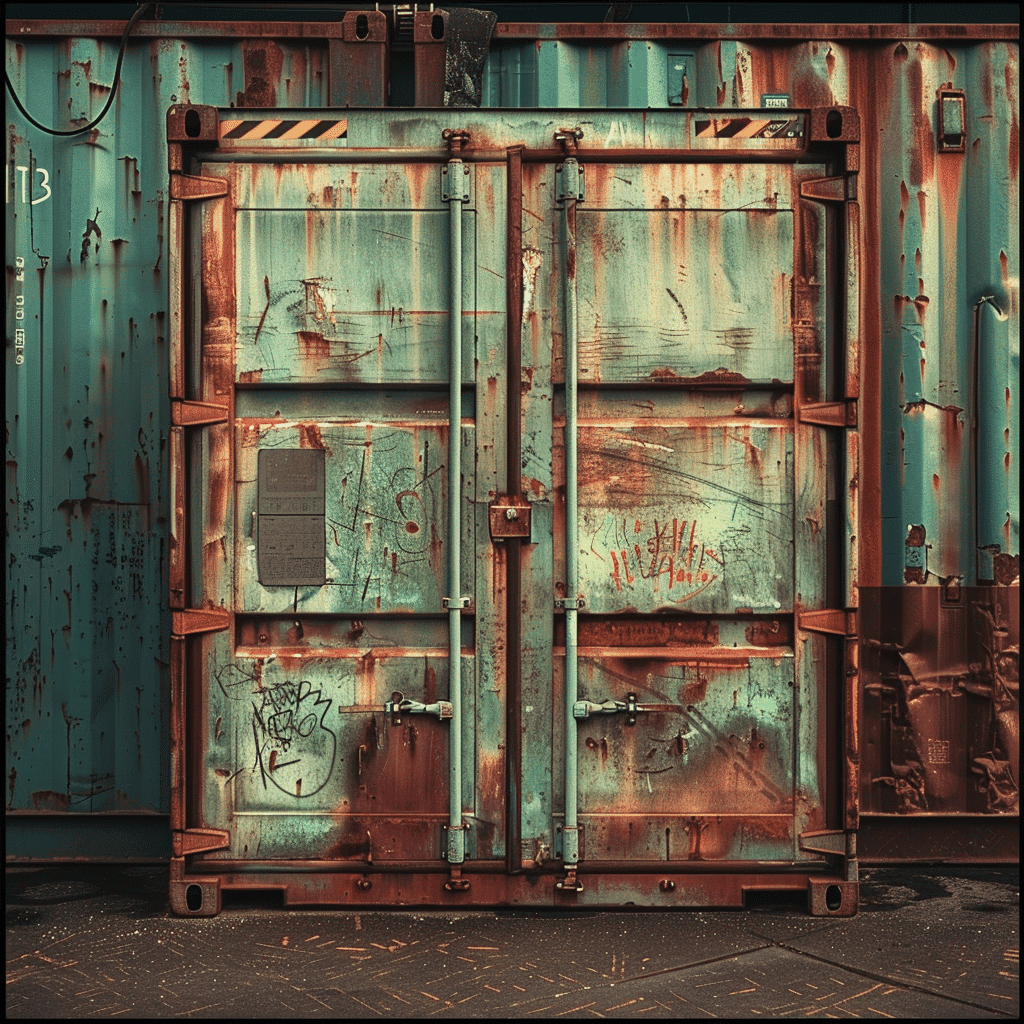Who’d have thought you’d be here, looking to spruce up a big metal box? Yet here you are, ready to transform your shipping container into something far from ordinary.
Don’t worry, you’ve got this. With a little prep work, the right materials, and a dash of elbow grease, you’ll have that steel container looking brand new.
Let’s dive into the nitty-gritty of how to paint your shipping container and give it the glow-up it deserves.
The Need and Benefits of Painting Shipping Containers
You might wonder why it’s necessary to paint your shipping container, but the benefits are numerous, ranging from aesthetics to long-term protection.
The first step in learning how to paint a shipping container is understanding the value it adds. A well-painted shipping container not only enhances its visual appeal but also provides a corrosion-resistant layer, which is crucial for containers exposed to a marine environment.
Using a marine grade paint is advisable when painting a shipping container, due to its resistance to harsh weather conditions. Besides, shipping container paint serves as an added layer of protection against external damage.
Therefore, if you want to prolong the life of your shipping containers, you should consider the benefits of painting shipping containers.

Different Options Based on Budget and Container Condition
Depending on your budget and the current condition of your shipping container, there’s a range of options you can consider when it’s time to paint.
If you’re dealing with a used shipping container with rust patches, you’ll need a pressure washer to clean the surface before applying primer. Masking tape comes in handy to cover areas you don’t want painted.
On a tight budget, a paint sprayer is an economical choice. It applies paint quickly and evenly, saving you time and paint.
If you can stretch your budget, consider using marine grade dtm paint. It’s specifically designed for durability in harsh conditions.
Whichever you choose, painting your shipping container properly will extend its lifespan and improve its appearance.
Cost Considerations
When considering the cost of painting your shipping container, it’s crucial to factor in not only the price of the paint itself, but also the potential expenses for necessary tools and preparations. Picking the best paint for the job can greatly influence cost considerations. Acrylic paint is a popular choice due to its durability and variety of paint colors. Depending on how much paint your container requires, you might need to budget for multiple cans.
Industrial paint sprayers, although more expensive initially, can save you money in the long run due to their efficiency. Remember to account for the cost of painting over or maintaining shipping line markings.
Prioritizing quality paint ensures that your shipping container’s paint color will last, making the investment worthwhile.
Preparation Steps Before Painting
Before diving into the actual painting process, it’s essential to properly prepare your used shipping container, ensuring a smooth and lasting paint job. The preparation steps before painting involve removing surface dirt and rust.
Start by using a wire brush to scrape off any surface rust from the steel surface. A trip to your local hardware store can provide you with the necessary tools like a wire brush and a razor blade.
Next, use a razor blade to scrape off any original paint that’s peeling or chipping. Be sure to wear proper protection during this process to avoid injuries.
Selecting The Right Paint
Choosing the right paint for your shipping container can make a significant difference in the outcome and durability of your paint job. When selecting the right paint, consider going for Sherwin Williams products, known for their quality and durability. Their paints provide a protective layer that slows down the corrosion process, a common issue with containers.
If your container has rust spots, opt for darker colors, as they’re better at concealing these imperfections. On the other hand, lighter colors reflect more sunlight, reducing heat build-up inside the container.
Determining How Much Paint You’ll Need
After settling on the right paint for your shipping container, you’ll need to calculate how much of it you’ll require for complete coverage. Start painting with a paint brush or a pneumatic paint sprayer, but remember that the number of coats you’ll need depends on your tools and the paint itself.
If you’re using a brush, one coat mightn’t be enough. You’ll likely need two coats or even an extra coat to get a smooth finish. On the other hand, a pneumatic sprayer tends to apply more coats in one go, so you might need less paint.
Determining how much paint you’ll need also involves considering the size of your container and the type of paint. So, plan well to ensure you have enough paint for the job.
Required Equipment and Supplies
Once you’ve determined the amount of paint needed, it’s time to gather the necessary equipment and supplies to paint your shipping container.
Primarily, you’ll need a wire wheel to remove any rust on the metal.A heat gun is handy to dry the container quickly.To clean the surface, you’ll require a power wash.For applying the paint, a brush and spray will be necessary.The brush helps you apply a solid base coat onto the metal, while the spray ensures an even spread of paint, especially in hard-to-reach corners.
Remember, your paint should be suitable for metal surfaces and in the color you desire. A final coat will give your container a professional finish.
Site Preparation for Painting
Where’s the best place to start your painting project? Site preparation for painting, of course!
Before slapping a fresh coat on those used containers, ensure they’re structurally sound. The process involves washing to remove dirt and grime, which could affect the adhesion of the paint.
Once the wash is done, inspect the containers for any affected areas that need repainting or repairs.
For the best results, use a water-based direct to metal paint. It adheres well to most surfaces and provides a durable, lasting finish.
Remember, proper site preparation for painting is the key to a successful project. It’s not just about making it look good, but also ensuring it’ll withstand the elements.
Step-by-Step Painting Process
Now, let’s dive into the actual step-by-step process of painting your shipping container.
First, you’ll need to prep the surface. This is a crucial step in the painting job, as it ensures the paint will adhere properly.
Next, apply the primer. This will protect the exterior from corrosion. Wait for the primer to dry before you move on.
Then, apply the first of two coats of paint. Make sure each coat is completely dry before applying the next.
This step-by-step painting process is designed to provide maximum protection for your shipping container. So, take your time and make sure each step is done properly.
Ultimately, the effort you put into painting your shipping container will be well worth it.

Frequently Asked Questions
What kind of paint do you use on a shipping container?
When painting a shipping container, the most recommended type of paint is marine-grade waterborne direct-to-metal (DTM) paint. This paint is specifically chosen for its durability and water-resistant properties, making it ideal for the metal surfaces of shipping containers. Additionally, if you’re planning to paint a mural or require visual branding on the container, acrylic paints are suggested.
Acrylic paints offer a range of vibrant shades and are suitable for more artistic or decorative purposes. However, they may not provide the same longevity or shine as alkyd enamel paints. The choice of paint ultimately depends on the specific needs and intended use of the shipping container, whether it’s for durability in harsh weather conditions or for aesthetic purposes.
Do you need to prime a shipping container before painting?
When preparing to paint a shipping container, the use of a primer is a crucial step to consider. Priming is essential as it forms a strong bond between the paint and the steel surface of the container. However, for shipping containers, it is recommended to use marine-grade self-priming paints.
These specialized paints eliminate the need for a separate coat of primer, streamlining the painting process. This approach not only ensures better paint adherence but also provides a more efficient solution for preparing the container for painting. The choice of self-priming marine-grade paint simplifies the task while ensuring durability and effectiveness in protecting the container’s surface.
How many gallons of paint do I need for a 40ft shipping container?
To paint a 40-foot shipping container, you will need approximately 5 gallons of paint. This quantity is sufficient for applying one coat of paint over the entire surface of the container. It’s important to note that the number of coats needed can vary depending on the paint color and the condition of the container.
For instance, if you’re using white or a lighter color, you might need more coats to ensure adequate coverage, especially if covering rust spots or darker areas. Therefore, while 5 gallons is a good starting point for a single coat, additional paint may be required for complete and even coverage.
How much does it cost to paint a 40 ft shipping container?
The cost of professionally painting a 40-foot shipping container typically ranges between $700 and $1600. This price variation depends on factors such as the depot location and the chosen color of the paint.
It’s noteworthy that lighter colors, like white, may incur an additional cost of around $100. This is because lighter shades often require an extra coat of paint to achieve full coverage and the desired finish. This cost estimate encompasses the professional labor and materials needed for a standard paint job on a shipping container of this size.
Conclusion
With a fresh coat of paint, your shipping container can evolve from a dull, rusty box into a vibrant, corrosion-resistant structure.
Did you know that a well-painted container can last over 25 years? That’s twice the lifespan of an untreated one!
So, grab your paintbrush, follow these steps and give your shipping container a new lease on life.
Remember, a little effort now can save you loads of time and money down the line.


